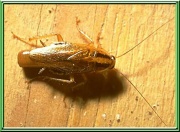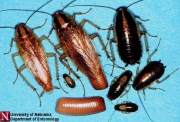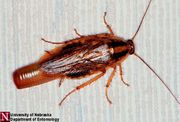Difference between revisions of "German cockroach"
| (2 intermediate revisions by the same user not shown) | |||
| Line 1: | Line 1: | ||
[[File:image11_germancockroach.jpg|thumb|German Cockroach]] | [[File:image11_germancockroach.jpg|thumb|German Cockroach]] | ||
== Description == | == Description == | ||
| − | + | [[File:Grm.cockroach.life.stages_Univ.Nebr.jpg|thumb|Brown banded cockroach (''Blattella germanica'')]] | |
A very common small, flat, tan cockroach, ''Blattella germanica'', that grows up to 14 mm long. The adult German cockroaches have two dark stripes. Both the nymphs and adults feed on almost anything, such as starchy, sugary, and proteinaceous foods. They will eat cloth sized with [[starch]] or [[glue]]. The adult insects (10-15 mm in length) can live almost 1 year. The female lay 30-40 eggs in a sausage-shaped case. The eggs hatch into nymphs in 14 days. Cockroaches are nocturnal and are sensitive to light. Common desiccating powders such as [[borax]], [[Dri-die]], and [[sulfur]] are used along with pesticides to exterminate cockroaches. | A very common small, flat, tan cockroach, ''Blattella germanica'', that grows up to 14 mm long. The adult German cockroaches have two dark stripes. Both the nymphs and adults feed on almost anything, such as starchy, sugary, and proteinaceous foods. They will eat cloth sized with [[starch]] or [[glue]]. The adult insects (10-15 mm in length) can live almost 1 year. The female lay 30-40 eggs in a sausage-shaped case. The eggs hatch into nymphs in 14 days. Cockroaches are nocturnal and are sensitive to light. Common desiccating powders such as [[borax]], [[Dri-die]], and [[sulfur]] are used along with pesticides to exterminate cockroaches. | ||
| − | [[File:Grm.cockroach. | + | [[File:Grm.cockroach.Adlt.Fem_Univ.Nebr.jpg|thumb|Brown banded cockroach (''Blattella germanica'')]] |
== Synonyms and Related Terms == | == Synonyms and Related Terms == | ||
| − | ''Blattella germanica''; croton bug; sternfly; Yankee sailor | + | ''Blattella germanica''; brown banded cockroach; croton bug; sternfly; Yankee sailor |
== Physical and Chemical Properties == | == Physical and Chemical Properties == | ||
Distribution: world-wide, primarily in indoor environments. | Distribution: world-wide, primarily in indoor environments. | ||
| − | |||
| − | |||
| − | |||
| − | |||
| − | |||
| − | |||
== Resources and Citations == | == Resources and Citations == | ||
Latest revision as of 15:05, 7 August 2022
Description
A very common small, flat, tan cockroach, Blattella germanica, that grows up to 14 mm long. The adult German cockroaches have two dark stripes. Both the nymphs and adults feed on almost anything, such as starchy, sugary, and proteinaceous foods. They will eat cloth sized with Starch or Glue. The adult insects (10-15 mm in length) can live almost 1 year. The female lay 30-40 eggs in a sausage-shaped case. The eggs hatch into nymphs in 14 days. Cockroaches are nocturnal and are sensitive to light. Common desiccating powders such as Borax, Dri-die, and Sulfur are used along with pesticides to exterminate cockroaches.
Synonyms and Related Terms
Blattella germanica; brown banded cockroach; croton bug; sternfly; Yankee sailor
Physical and Chemical Properties
Distribution: world-wide, primarily in indoor environments.
Resources and Citations
- MuseumPests.net: German Cockroach
- University of Florida, Department of Entomology and Nematology: German cockroach
- Cockroach Facts website: German cockroach
- Lynda A. Zycherman, J.Richard Schrock, A Guide to Museum Pest Control, FAIC and Association of Systematics Collections, Washington DC, 1988
- Univ. of Florida, Dept. of Entomology at https://edis.ifas.ufl.edu/in128 (Accessed March 2020)


